The Place de la Concorde: From King’s Square to Green Garden


- SUBSCRIBE
- ALREADY SUBSCRIBED?
BECOME A BONJOUR PARIS MEMBER
Gain full access to our collection of over 5,000 articles and bring the City of Light into your life. Just 60 USD per year.
Find out why you should become a member here.
Sign in
Fill in your credentials below.
The Place de la Concorde has seen many changes during its 250-year history, its most recent incarnation being the site of the breakdancing competitions at the 2024 Olympic Games. It is due to undergo yet another transformation over the next few years but despite its name, the place has been anything but peaceful during its existence.
The square was originally laid out in the 1760s to celebrate King Louis XV’s recovery from a serious illness. (He had a habit of building grand monuments after recovering from illness: after an earlier bout, possibly of syphilis, he ordered the construction of the Panthéon to replace the medieval abbey church dedicated to St Geneviève.) A competition was held to design a bronze equestrian statue of the king and a new open space around it. The winner was Jacques-Ange Gabriel, whose design included two buildings that are now the Hôtel de Crillon and Hôtel de la Marine. To celebrate the king’s return to health, a space known as the Esplanade du Pont-Tournant, at the bottom of the Jardin des Tuileries, was laid out as a public square. Historically it was next to the wharf where marble was unloaded. The statue was inaugurated in 1763 and the esplanade was renamed simply Place Louis XV.

Ceremony on the Place Louis XV in 1763. Bibliothèque nationale de France. Wikimedia commons
At the time, the Champs Elysées really were the Elysian Fields, more or less: gardens landscaped by Louis XIV’s designer André le Nôtre stretched as far as the current Rond-Point with open countryside leading upwards to the Butte de Chaillot, where the Arc de Triomphe now stands. Views south towards the Seine were broken only by Marie de Medici’s 17th-century carriage route, the Cours-la-Reine.
In 1770 a firework display to celebrate the marriage of the Dauphin Louis and Marie-Antoinette went disastrously wrong when a rocket came down into a store of fireworks, setting them off. The assembled crowd panicked and in their haste to escape, dozens fell into the dry moats that encircled the square. Men carrying their swords drew them and tried to make space for themselves, injuring more people as they did so. Thirty people died and over 100 more were injured; the bodies were buried next to the Madeleine.
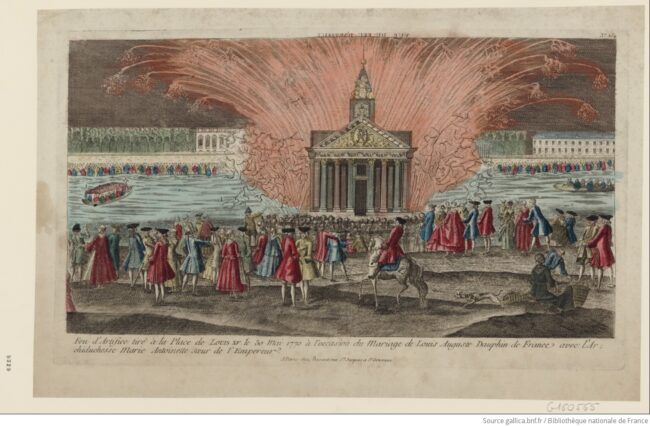
Feu d’artifice tiré à la place de Louis XV le 30 mai 1770, à l’occasion du mariage de Louis Auguste Dauphin de France avec l’archiduchesse Marie Antoinette. Illustration, Bibliothèque nationale de France
Apart from that disaster, these outskirts of Paris remained otherwise peaceful for just over 20 years. But come the Revolution, and the Place Louis XV lost its royal name to the more utilitarian Place de la Révolution and a guillotine was erected. Although it was not the only guillotine in use in Paris at this time, this one saw the execution of all the “star” names of the Revolution. The king and queen were victims, of course, as were many of the political leaders who, one by one, fell foul of the increasing tyranny of the régime which finally fell into the bloodbath known as the Reign of Terror, including Danton and finally Robespierre himself.
But no revolution lasts forever and by 1795 the Terror had worked itself out. In a spirit of optimism for the future, the ruling Directory renamed the square Place de la Concorde, only for it to revert to royalism during the Restoration, when Charles X changed it yet again to Place Louis XVI in commemoration of his executed brother.

François Dubois (1790-1871). “Erection de l’obélisque de Louqsor (Louxor) sur la place de la Concorde, le 25 octobre 1836”. Huile sur toile. Paris, musée Carnavalet.
It was only after the July Revolution in 1830 that the name finally and permanently became Place de la Concorde. The “bourgeois” king, Louis-Philippe, installed the 3000-year-old obelisk of Luxor in the center in 1836 as a non-political statement (no doubt to everyone’s relief, after the turmoil of the previous 47 years) and the ornate bronze fountains depicting navigation scenes were added. And then the Place entered its modern incarnation as Paris’s biggest place and one of its busiest traffic interchanges. Around 5,400 vehicles encircle it every hour.
All that is about to change, however. Along with the Place de Catalogne (14e arrondissement), the Bois de Charonne and the Parvis de l’Hôtel de Ville, the Place de la Concorde has been designated a site for an “urban forest.”
These urban forests are a flagship project in the Ville de Paris’ fight to mitigate the effects of climate change. The Bois de Charonne, previously described here is well underway and the Place de Catalogne is completed. The Place de la Concorde is still in the planning stages but within three to four years it will look radically different.
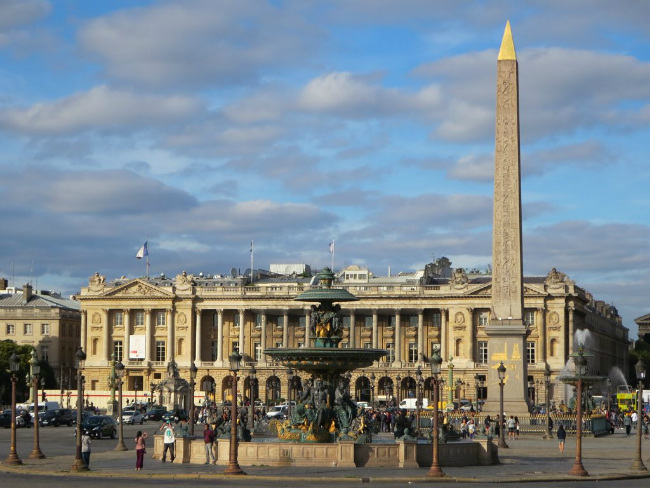
Place de la Concorde and the obelisk. Photo: David Stanley/ Flickr
In spring 2024 Mayor Anne Hidalgo convened a 17-strong commission including heritage experts, historians, climatologists and UNESCO’s World Heritage Director to produce a report on the future of the largest and best-known square in Paris. It came up with 12 “must-have” recommendations to be incorporated in the final design, including a commitment to retain the square’s central symmetry and its iconic perspectives between the Madeleine and Assemblée Nationale across the river, and from the Jardin des Tuileries up the Champs Elysées to the Arc de Triomphe.
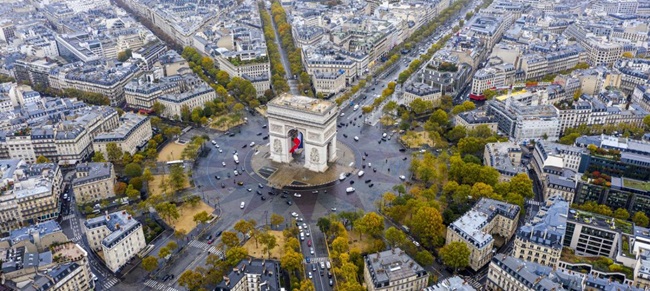
Champs Élysées. Photo credit: iStock – GlobalP
The ensuing competition was won by heritage architect Philippe Prost and his landscape artist Anne-Sylvie Bruel. They have a tricky task ahead of them: the Place de la Concorde is not only inscribed in France’s register of historic monuments, and a former royal place, but it is also a UNESCO World Heritage site. But their plan brings together modern climate management with respect for history.
The symmetry between the obelisk and the fountains in the center of the square is maintained while large grassy areas accessible to the public will replace the current expanses of concrete and paving. The original boundary moats on the east and west sides will be dug out again, more shallowly, and planted with trees. They will provide potential reservoirs for heavy rainfall, able to hold up to five days’ worth of rain, or the equivalent of a once-in-a-century flood, thus relieving pressure on the sewage system. Fifty percent of the total surface area will also become permeable once again, allowing rainfall to soak through and replenish the groundwater system.
Just as importantly, the 60%-30% ratio of vehicles to pedestrians will be reversed and two-thirds of its area will be pedestrian-only, with vehicle traffic restricted to the Champs-Elysées side. The side bordering the Jardins des Tuileries will be prioritized for bicycles.
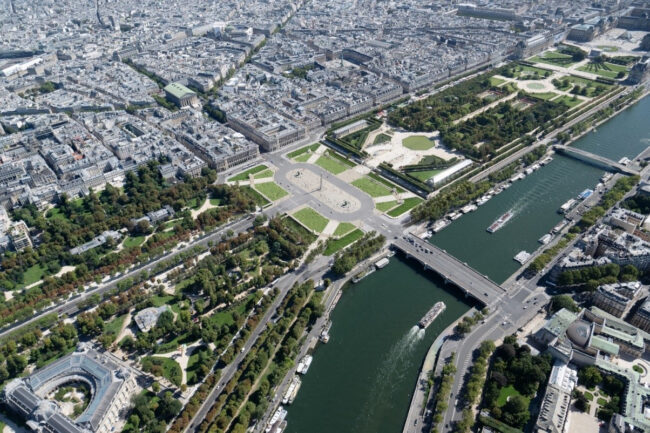
Perspective du projet de Philippe Prost / Bruel-Delmar. Crédit: Place de la Concorde, Paris Philippe Prost, architecte/AAPP ©️ Jeudi Wang ©️ adagp, 2025
Looking south, the place will be physically linked to the quayside of the river Seine. Depending on the approval of the Préfecture de Police which manages traffic in Paris, the artery that runs alongside the Cours-la-Reine will be closed and covered with earth, then planted with a double line of trees. The road is the continuation of the Voie Georges Pompidou, the 1970s creation of a vehicle-choked underpass which used to run along the lower quaysides of the Seine until it was closed to create the pedestrianized Rives de Seine.
If this section is also closed, it will symbolically mark the end of an era, inaugurated in the 1960s, of the car dominating Paris roads. The width of the quayside promenade will triple, from 10m to 30m. Between the place and the river will be a continuous shaded walk and the whole area including the Place de la Concorde will reduce the ambient temperature by as much as 8.5°C in high summer. A former “hot island” will be transformed into a “cool island.”
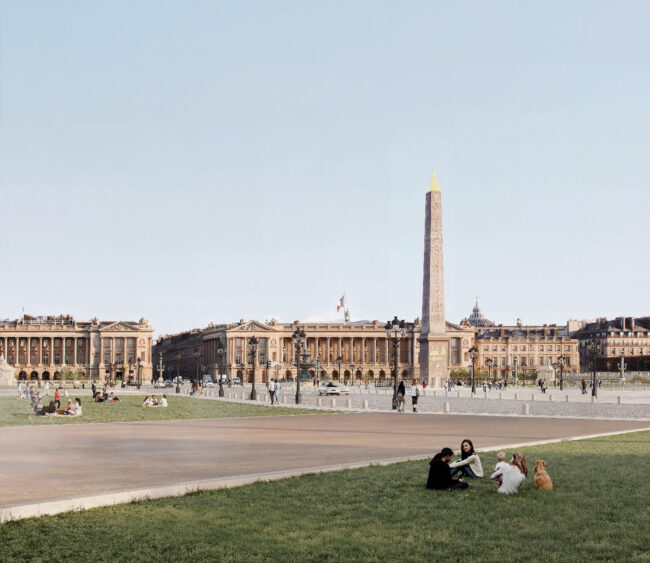
Perspective du projet de Philippe Prost / Bruel-Delmar. Crédit: Place de la Concorde, Paris Philippe Prost, architecte/AAPP ©️ Jeudi Wang ©️ adagp, 2025
For Anne Hidalgo, this is likely to be her swansong. Her current term as mayor expires in 2026 and she is not standing for reelection to a third term. Her predecessor, Bertrand Delanöe, is credited for revitalizing Paris after a period of decline in the 1990s and Hidalgo, despite her many detractors, has undoubtedly built on that legacy. She has pushed through some far-reaching changes to Paris that have begun to face the challenges of the climate crisis as well as making it a much more pleasant city to move around in. A green, cooler Place de la Concorde in the city’s center will be a fitting goodbye.
Lead photo credit : Place de la Concorde as seen from the Eiffel Tower. Photo: Cristian Bortes / Wikimedia commons
More in green, Olympics, place de la concorde, sustainable, urban forests


